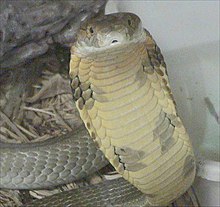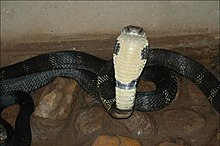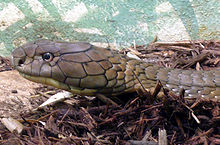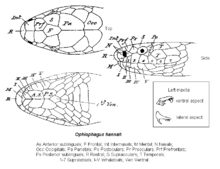The king cobra is the sole member of genus Ophiophagus, while most other cobras are members of the genus Naja. They can be distinguished from other cobras by size and hood marks. King cobras are generally larger than other cobras, and the stripe on the neck is like the symbol "^" instead of a double or single eye shape(s) that may be seen in most of the other Asian cobras. A foolproof method of identification is if on the head, clearly visible, is the presence of a pair of large scales known as occipitals, at the back of the top of the head. These are behind the usual "nine-plate" arrangement typical of colubrids and elapids, and are unique to the king cobra.
The king cobra averages at 3 to 4 meters (9.8 to 13 ft) in length and typically weighing about 6 kilograms (13 lb). The longest known specimen was kept captive at the London Zoo, and grew to around 18.5 to 18.8 feet (5.6 to 5.7 m) before being euthanized upon the outbreak of World War II. The heaviest wild specimen was caught at Royal Island Club in Singapore in 1951 which weighed 12 kilograms (26 lb) and measured 4.8 meters (16 ft), though an even heavier captive specimen was kept at New York Zoological Park and was measured as 12.7 kilograms (28 lb) at 4.4 meters (14 ft) long in 1972. Recently a 12ft king Cobra was found in Tripura(India).[citation needed] The length and mass of the snakes highly depend on their localities and some other factors. Despite their large size, typical king cobras are fast and agile.
The skin of this snake is either olive-green, tan, or black, and it has faint, pale yellow cross bands down the length of the body. The belly is cream or pale yellow, and the scales are smooth. Juveniles are shiny black with narrow yellow bands (can be mistaken for a banded krait, but readily identified with its expandable hood). The head of a mature snake can be quite massive and bulky in appearance, though like all snakes, they can expand their jaws to swallow large prey items. It has proteroglyph dentition, meaning it has two short, fixed fangs in the front of the mouth which channel venom into the prey like hypodermic needles. The male is larger and thicker than the female. The average lifespan of a wild king cobra is about 20 years.
The dorsal scales along the center of the king cobra's body have 15 rows. Males have 235 to 250 ventral scales, while females have 239 to 265. The subcaudal scales are single or paired in each row, numbering 83 to 96 in males and 77 to 98 in females.
Bioacoustic analysis of the "growl" of the king cobra has shown that it differs significantly from other snakes. Generally a typical snake hiss has a broad-frequency span [~3,000 to 13,000 Hz] with a dominant frequency near 7,500 Hz, whereas the "growl" of the king cobra consists of frequencies below 2,500 Hz, with a dominant frequency near 600 Hz.




No comments:
Post a Comment